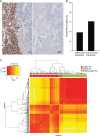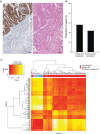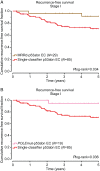Clinicopathological and molecular characterisation of 'multiple-classifier' endometrial carcinomas
- PMID: 31829447
- PMCID: PMC7065184
- DOI: 10.1002/path.5373
Clinicopathological and molecular characterisation of 'multiple-classifier' endometrial carcinomas
Abstract
Endometrial carcinoma (EC) molecular classification based on four molecular subclasses identified in The Cancer Genome Atlas (TCGA) has gained relevance in recent years due to its prognostic utility and potential to predict benefit from adjuvant treatment. While most ECs can be classified based on a single classifier (POLE exonuclease domain mutations - POLEmut, MMR deficiency - MMRd, p53 abnormal - p53abn), a small but clinically relevant group of tumours harbour more than one molecular classifying feature and are referred to as 'multiple-classifier' ECs. We aimed to describe the clinicopathological and molecular features of multiple-classifier ECs with abnormal p53 (p53abn). Within a cohort of 3518 molecularly profiled ECs, 107 (3%) tumours displayed p53abn in addition to another classifier(s), including 64 with MMRd (MMRd-p53abn), 31 with POLEmut (POLEmut-p53abn), and 12 with all three aberrations (MMRd-POLEmut-p53abn). MMRd-p53abn ECs and POLEmut-p53abn ECs were mostly grade 3 endometrioid ECs, early stage, and frequently showed morphological features characteristic of MMRd or POLEmut ECs. 18/28 (60%) MMRd-p53abn ECs and 7/15 (46.7%) POLEmut-p53abn ECs showed subclonal p53 overexpression, suggesting that TP53 mutation was a secondary event acquired during tumour progression. Hierarchical clustering of TCGA ECs by single nucleotide variant (SNV) type and somatic copy number alterations (SCNAs) revealed that MMRd-p53abn tumours mostly clustered with single-classifier MMRd tumours (20/23) rather than single-classifier p53abn tumours (3/23), while POLEmut-p53abn tumours mostly clustered with single-classifier POLEmut tumours (12/13) and seldom with single-classifier p53abn tumours (1/13) (both p ≤ 0.001, chi-squared test). Finally, the clinical outcome of patients with MMRd-p53abn and POLEmut-p53abn ECs [stage I 5-year recurrence-free survival (RFS) of 92.2% and 94.1%, respectively] was significantly different from single-classifier p53abn EC (stage I RFS 70.8%, p = 0.024 and p = 0.050, respectively). Our results support the classification of MMRd-p53abn EC as MMRd and POLEmut-p53abn EC as POLEmut. © 2019 The Authors. The Journal of Pathology published by John Wiley & Sons Ltd on behalf of Pathological Society of Great Britain and Ireland.
Keywords: POLE; endometrial cancer; molecular classification.
© 2019 The Authors. The Journal of Pathology published by John Wiley & Sons Ltd on behalf of Pathological Society of Great Britain and Ireland.
Figures




References
-
- McAlpine J, Leon‐Castillo A, Bosse T. The rise of a novel classification system for endometrial carcinoma; integration of molecular subclasses. J Pathol 2018; 244: 538–549. - PubMed
-
- Colombo N, Creutzberg C, Querleu D, et al Appendix 5: endometrial cancer: eUpdate published online 8 June 2017 (http://www.esmo.org/Guidelines/Gynaecological-Cancers). Ann Oncol 2017; 28(suppl_4): iv153–iv156. - PubMed
-
- Van Gool IC, Rayner E, Osse EM, et al Adjuvant treatment for POLE proofreading domain‐mutant cancers: sensitivity to radiotherapy, chemotherapy, and nucleoside analogues. Clin Cancer Res 2018; 24: 3197–3203. - PubMed

